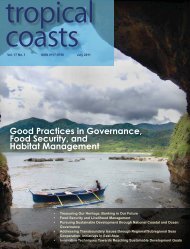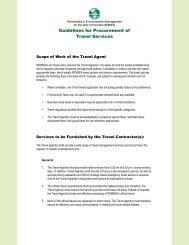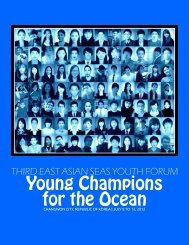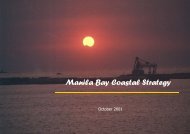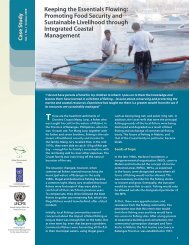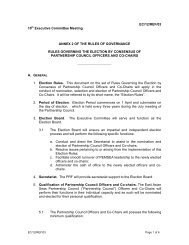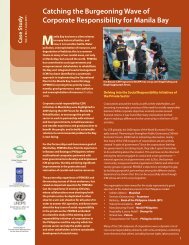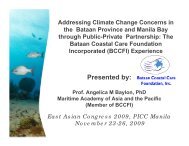Download PDF Copy - Pemsea
Download PDF Copy - Pemsea
Download PDF Copy - Pemsea
You also want an ePaper? Increase the reach of your titles
YUMPU automatically turns print PDFs into web optimized ePapers that Google loves.
local Chief Executives, policymakers, resource managers and<br />
investors with clear direction on developmental activities that<br />
are compatible with sustainable use of marine and coastal<br />
resources and coastal areas.<br />
Water Use and Supply Management<br />
Indications are that access to water supply in the Province has<br />
improved since 1990. Development and annual investment<br />
plans include substantial investment to tap and maintain<br />
connections to water sources and access to safe water<br />
supplies. Seventy-seven percent of the Province is considered<br />
difficult for purposes of well construction, with static<br />
groundwater levels in central coastal municipalities greater<br />
than 40 m below ground level. However, at present, there are<br />
no strategies or initiatives at the provincial or municipal levels<br />
covering regulation and conservation of freshwater usage.<br />
Watershed reforestation and urban greening, as well as water<br />
use rationalization through regulation and market-based<br />
instruments need to be considered.<br />
In terms of access to safe potable water, there has been a<br />
slight decrease in the incidence of waterborne diseases from<br />
2000 to 2007. Nonetheless, waterborne diseases, particularly<br />
diarrhea, remain the top cause of morbidity in the area.<br />
Seventeen deaths due to diarrhea were recorded in 2006,<br />
while seven deaths were reported in 2007. These figures point<br />
out the urgent, continuing need to protect water supplies from<br />
contamination, and to provide adequate water treatment and<br />
supply services to communities of the Province.<br />
integrated into the SEMP, is a step in the right direction.<br />
Fisheries sustainability cannot be assessed using existing<br />
data. Improvements in data collection and management<br />
would facilitate implementation and evaluation of the<br />
fisheries management plan. In addition, unified fishery<br />
legislation is recommended to tie up the efforts of all the<br />
municipalities in sustaining their fishery resources.<br />
Pollution Reduction and Waste Management<br />
The province and the municipalities have developed<br />
plans and strategies for pollution reduction and waste<br />
management. The next focus is the heightened<br />
implementation of these action programs. Agricultural and<br />
municipal solid waste and domestic sewage continue to<br />
be priority challenges across the Province, resulting in<br />
the deterioration of freshwater and marine water quality,<br />
contamination of water supplies, and river and coastal<br />
ecosystems. The enactment and/or strict enforcement<br />
of ordinances for the management of agricultural wastes<br />
are necessary, considering the extensive contamination<br />
of groundwater and rivers with nutrients and pathogens<br />
as a consequence of mismanagement of livestock<br />
residues and chemical fertilizers. The construction of<br />
sanitary landfills and sewerage facilities is beyond the<br />
capacity of most municipalities in the Province. Therefore,<br />
the Province needs to consider taking the lead for the<br />
municipalities by introducing innovative and cost-effective<br />
approaches in waste management, in partnership with<br />
specialized institutions/organizations and the private<br />
sector.<br />
Food Security and Livelihood Management<br />
Malnutrition rates in the Province are on a general decline<br />
since 1995. Opportunities for employment as well as the<br />
absolute numbers of people employed have increased in<br />
Batangas since 1990. However, because of population<br />
growth, poverty incidence and unemployment rates have<br />
been constant or on a slightly increasing trend over the<br />
same period. Elementary and secondary school attendance<br />
rates have increased since 2003, and the proportion of high<br />
school graduates, 18 years of age and above, is higher than<br />
the national average. This trend, if continued, will help the<br />
Province to reverse the poverty incidence and unemployment<br />
rate over time.<br />
Considerable effort has been made to improve fisheries<br />
management and a fisheries management plan (2005–2020),<br />
Overall, ICM implementation in the Province of Batangas<br />
has resulted in positive signs, particularly in the<br />
governance elements of the sustainable development<br />
framework. However, as this SOC report indicates, these<br />
are only the first steps and much still remains to be done<br />
before the objectives and goals of the Provincial SEMP<br />
are achieved.<br />
Progress is evident, as is the continuing commitment<br />
of the Provincial and municipal governments to the<br />
cause of sustainable development. With the Governor’s<br />
strong leadership and the dedication of all concerned<br />
stakeholders to ICM implementation, we are assured that<br />
the natural services and benefits provided by our marine<br />
and coastal resources will be protected and managed<br />
for our own well-being and as a legacy for future<br />
generations.<br />
State of the Coasts of Batangas Province<br />
9



